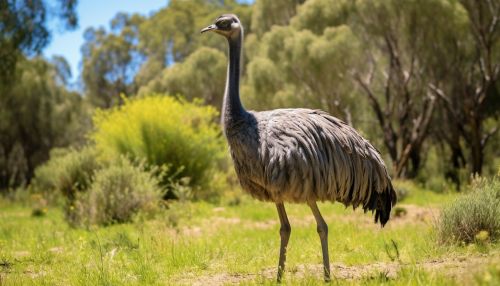Emu
Taxonomy and Evolution
The emu, scientifically known as Dromaius novaehollandiae, is the second-largest living bird by height, after the ostrich. It is endemic to Australia where it is the largest native bird and the only extant member of the genus Dromaius. The emu is an important cultural icon of Australia, appearing on the coat of arms and various coins.
The emu is a member of the Ratite family, a group of flightless birds that also includes the ostrich, kiwi, and cassowary. The emu's ancestors diverged from the lineage that led to the kiwi around 40 million years ago, and around 30 million years ago from the lineage that led to the cassowary and ostrich. The divergence of the emu and cassowary lineages is estimated to have occurred around 10 million years ago.


Description
Emus are large birds. The largest individuals can reach up to 150–190 cm (59–75 in) in height. Males are slightly smaller than females, which can weigh between 18 and 48 kg (40 and 106 lb), while males weigh between 18 and 45 kg (40 and 99 lb). Emus have long necks, sharp beaks and small ears. They have two sets of eyelids, one for blinking and one for keeping out dust. Their long legs are adapted for speed and endurance, and their feet have only three toes.
Behavior and Ecology
Emus are diurnal birds and spend their day foraging, preening their plumage with their beak, dust bathing and resting. They are nomadic and will travel long distances to find food. Their diet consists mainly of a variety of plants, insects, and small animals. Emus ingest stones, glass shards and bits of metal to grind food in the digestive system. They drink infrequently, but take in copious fluids when the opportunity arises. Emus will sit in water and are also able to swim. They are curious birds who are known to follow and watch other animals and humans. Emus do not sleep continuously at night but in several short stints sitting down.
Emus use their strongly clawed feet as a defence mechanism. Their legs are among the strongest of any animals, powerful enough to tear down metal wire fences.
Reproduction
Emus form breeding pairs during the summer months of December and January, and may remain together for about five months. During this time, the pair will mate every day or two, and every second or third day, the female will lay an egg. Unlike most birds, which lose and replace a few feathers at a time, emus lose all their feathers at once when they moult. Both sexes grow a layer of darker feathers underneath that will be used for incubating eggs.
The male emu incubates the eggs and raises the chicks, and he does not eat or drink during this time. Emu chicks are precocial and are able to leave the nest and feed themselves as soon as they hatch. They remain with their father for up to 18 months, until they become independent.
Relationship with Humans
Emus have been hunted by humans for thousands of years for their meat, feathers, and oil. Today, they are farmed for these products, and their leather is also used. Emus are not considered threatened or endangered, but their habitats are under threat from human activities.
